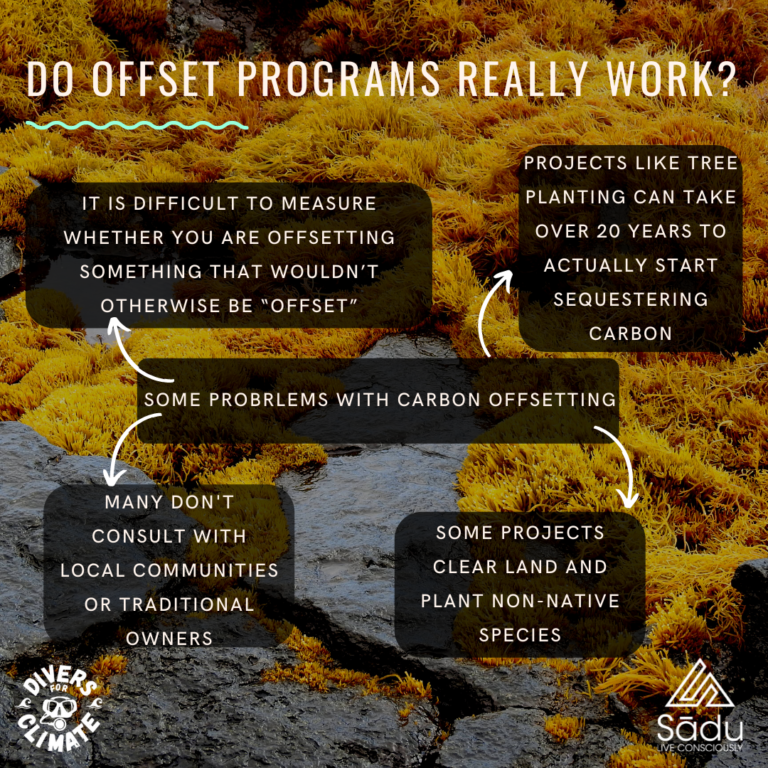A divers guide to carbon offsetting
A collaboration by Sādu x Divers for Climate
Something that we divers have in common is our love of travel. But how can we ensure, as ocean advocates, that our dive travels are as climate friendly as possible? Following our most recent blog ‘To travel or not to travel? The divers for climate dilemma’, in this article we’ll be talking all about carbon offsetting; namely – what it is, why it is useful, does it work and how to choose an offset program.

firstly, what is ‘carbon offsetting’?
Put simply, to solve the climate crisis, we must reduce the amount of greenhouse gases in the atmosphere. We can do this in two ways: (1) we can stop putting it there and (2) we can take some of it out. Both are extremely necessary, because even if we stopped all emissions today, the greenhouse gases that are already trapped in the atmosphere would continue to wreak havoc for decades to come.
Taking carbon out of the atmosphere and storing it is called carbon sequestration, and thankfully, nature has a way of doing this for us through ecosystems known as “carbon sinks”. These can be either terrestrial (called land sinks) or marine (called coastal and ocean sinks) and we bet you can recognise some of them. Rainforests, coral reefs, kelp forests and seagrass meadows are all carbon sinks, i.e., they absorb carbon from the atmosphere and store it. Therefore, protecting and restoring these ecosystems is a key climate solution.
Now, carbon offsetting schemes or programs offer a way to “balance out” or “neutralise”carbon emissions. For example, say you take a flight from A to B and add an extra 250kg of emissions to your personal carbon footprint. In theory, to lessen your impact on the planet, you can balance out this exact amount by investing in or donating to offset schemes that take carbon back out of the atmosphere.Technically, if you offset as much as you emit, you reach what we call “net zero”.
Offset schemes can come in many forms. The most traditional and well-known are those that restore our precious carbon sinks (e.g. tree planting in rainforests or more recently, seaweed restoration). However, they can also include investing in projects that are designed to reduce future emissions (such as wind and solar energy). To offset emissions, individuals and businesses can calculate the amount they want to offset (e.g. by using an offset calculator like this one) and then invest or donate to an offsetting scheme of their choice.
does offsetting actually work?
As with all climate solutions, carbon offsetting is not straightforward and several limitations exist. Let’s take tree planting projects for example (as this is what most people think of when they hear the term “carbon offset”). Tree planting projects are generally slow and can take over 20 years to start sequestering carbon (that’s time that we definitely don’t have). If done incorrectly, they can also be quite bad for the environment. For example, some projects clear large amounts of land and plant non-native trees. Not to mention, many tree-planting projects do not consult with local communities.
Beyond tree planting, the biggest problem with offsetting in general, is that it is difficult to measure whether you are offsetting something that wouldn’t otherwise be “offset” (i.e. Are you actually balancing out your emissions or taking credit for something that was going to happen anyway? Are your emission savings being “double counted”?). While that’s not to say offsetting is not a good thing, it does mean that we need to be careful when choosing which projects to support.


How do you know if an offsetting project is good?
In the end, while it’s not a silver bullet solution, if done properly offsetting can help us take on a climate changed world. To avoid any offsetting pitfalls, here are some general guidelines to follow when selecting an offsetting program:
Choose projects that protect (or prevent the loss of) existing areas. The best and fastest way to absorb carbon out of the atmosphere is to protect the carbon sinks that already exist. For example, if protected properly, ecosystems such as mangroves can absorb up to 1000 tonnes of carbon per hectare (that’s equivalent to over 900 flights from Australia to the UK) and four times the amount than rainforests. Projects that protect and preserve our natural carbon sinks, especially our marine ones, are far more likely to have a positive impact on our climate .
Make sure that they work with local communities. It goes without saying that involving local communities in decision-making and planning (through to implementation) is crucial when it comes to protecting our environment, in particular, collaboration with Indigneous communities. Make sure that any project you contribute to is largely led by those with a deep understanding of the local environment and provides benefits to those living nearby (e.g. jobs).
Check whether they use sustainable or regenerative methods. To make their project happen, do they clear unnecessary land? Does it harm the local environment? Are they planting native vegetation? Are they using harmful chemicals or unethical practices (e.g. slave labour)? Make sure to dig deep and check that the program is rooted in sustainable and ethical practices.
Check where they get their money from. It is not uncommon for big polluting corporations to fund offsetting programs to make themselves look better. Ask yourself, who is behind this offsetting program? Where does the money come from? It is important to make sure that the people benefitting from the program are not the ones destroying the planet.
introducing Sādu
It can be difficult trying to navigate the world that is carbon offsets. Thankfully, there are incredible people like the co-founders of Sādu App who are here to help.
Sādu is a mobile exercise app with a twist. It connects personal well-being to the environment by allocating financial contributions to carbon offsetting projects for every calorie burned. That is, Sādu rewards workouts with offsets, allowing you to take care of yourself and the planet at the same time.
The team at Sādu have carefully selected several carbon offsetting projects (including SeaTrees, a kelp forest restoration project) that largely follow the guidelines laid out above – choosing which carbon offset project to support has never been easier! All you need to do is download the app from their website or head to their Instagram page to learn more about the offsetting projects they work with.

